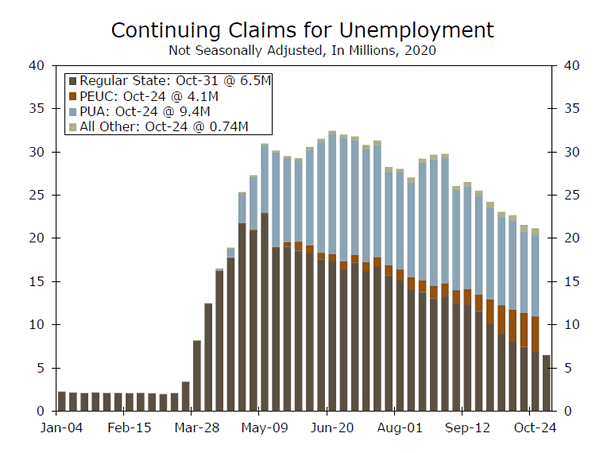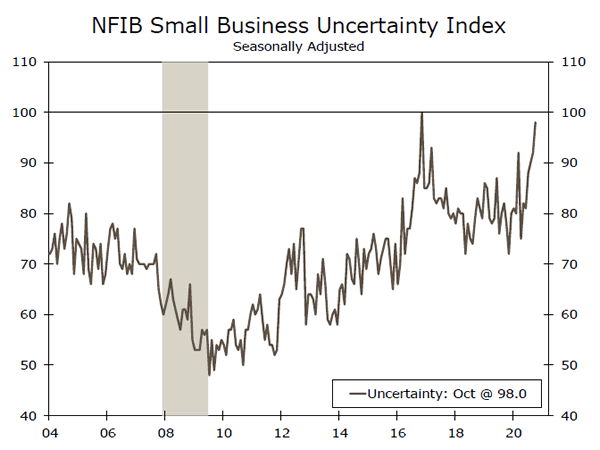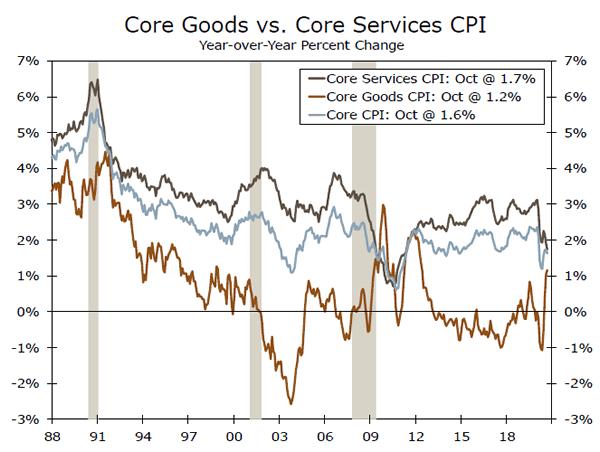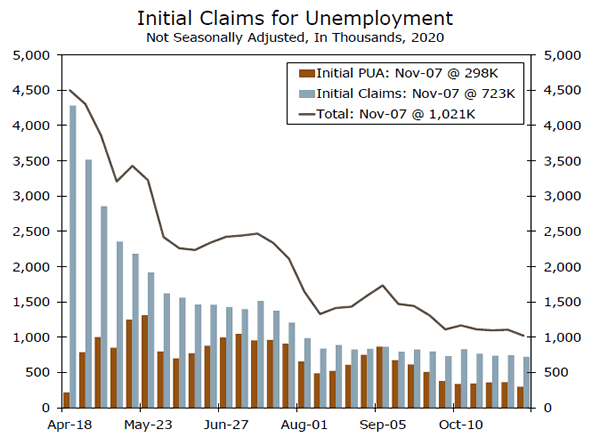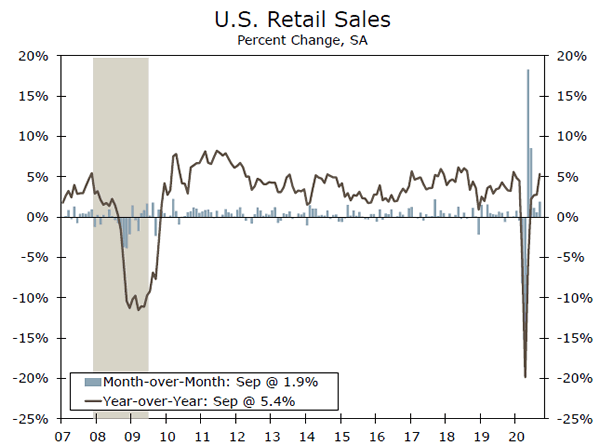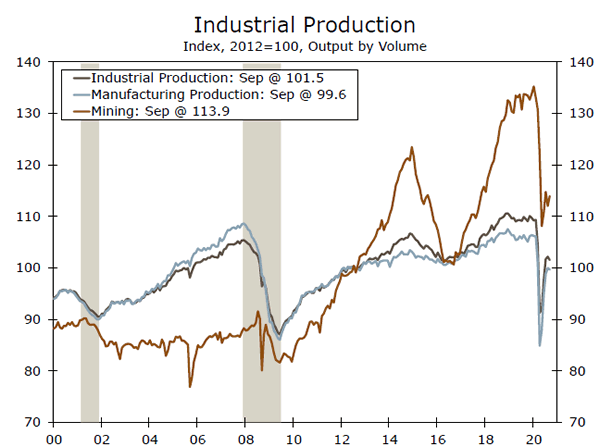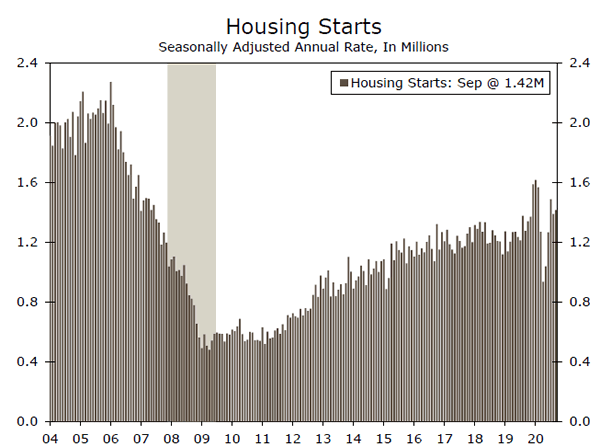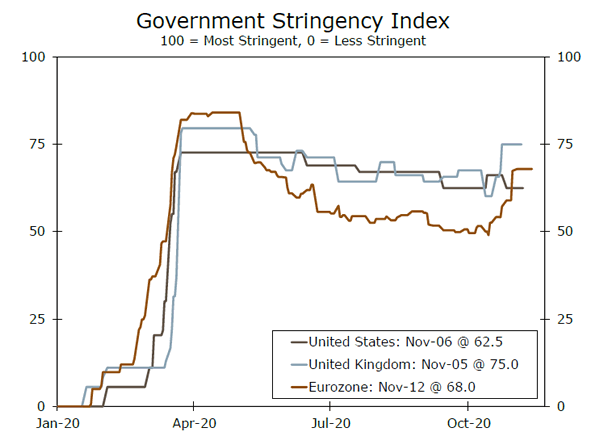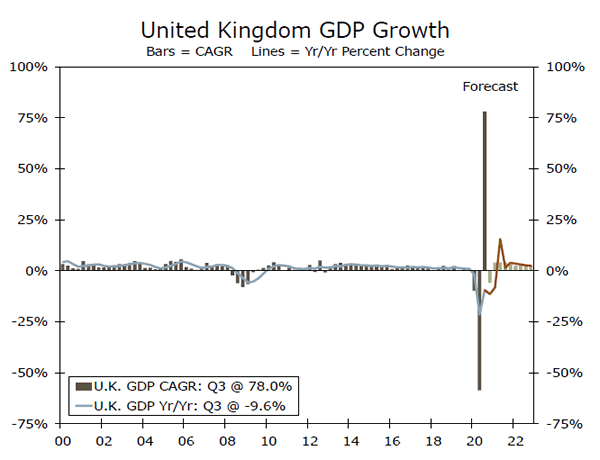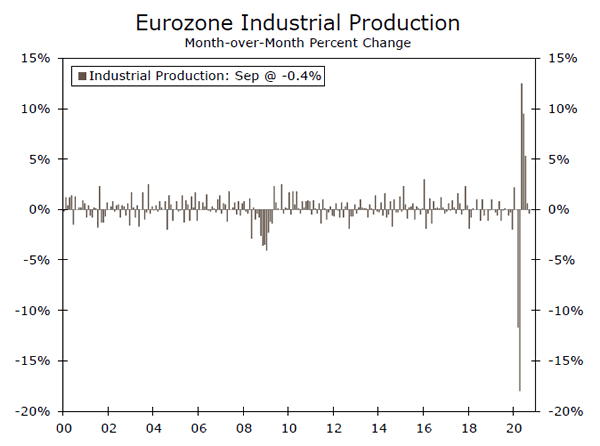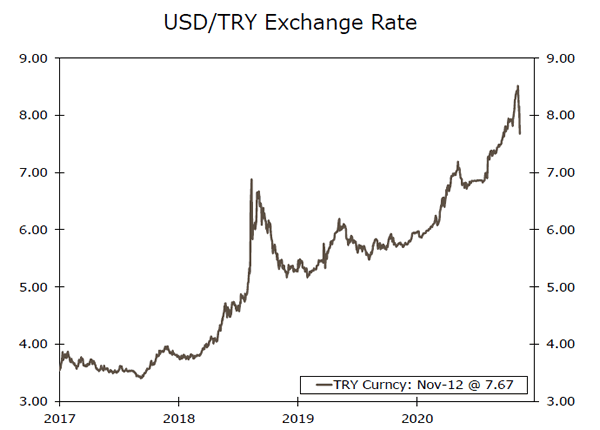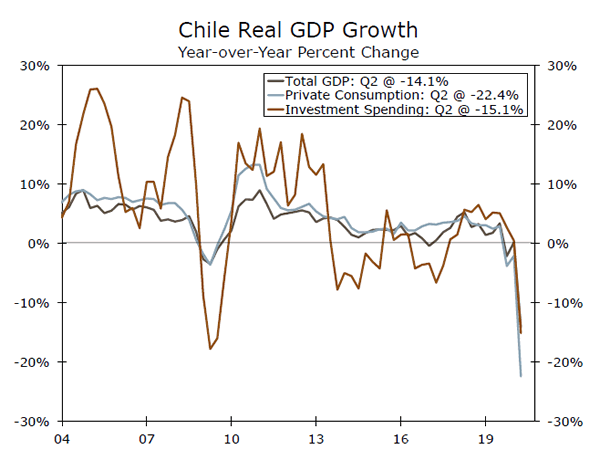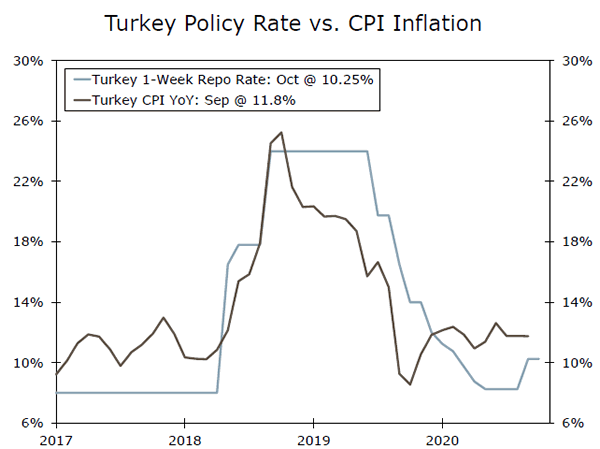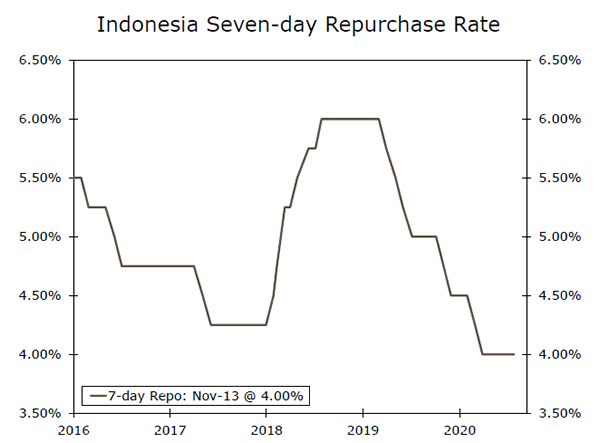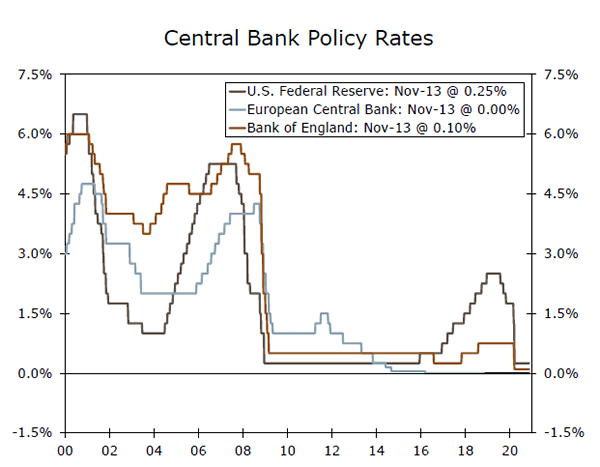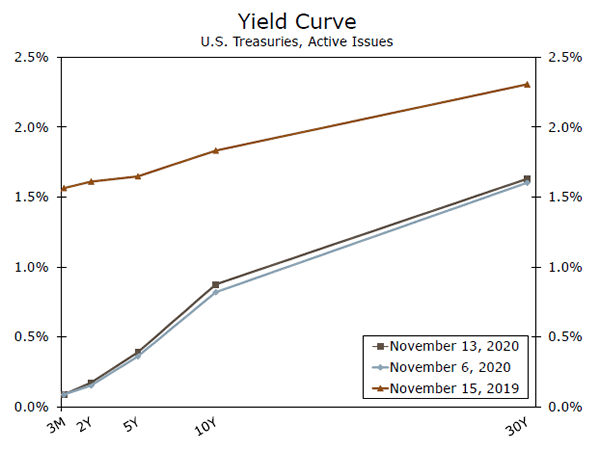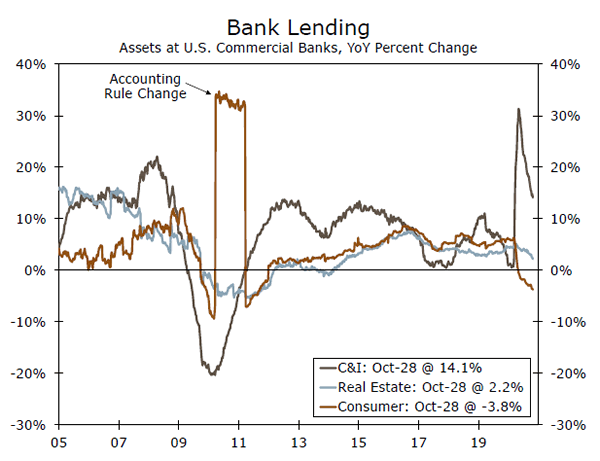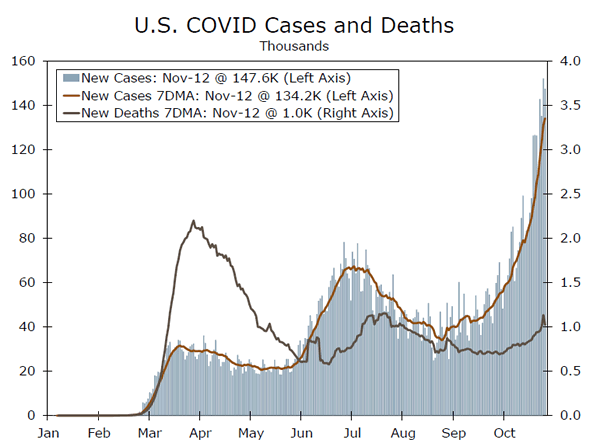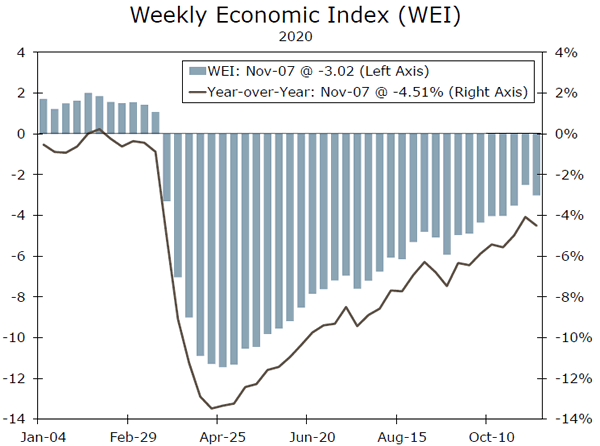U.S. Review
Vaccination Record
- The combination of the election outcome and a workable vaccine boosted financial markets and set the background music for this week’s short list of indicators. See Topic of the Week for our take on the economic implications of the vaccine.
- Small businesses reported near-record uncertainty in October amid the pandemic and a divisive election.
- Initial jobless claims may be edging lower, but the fact that more than 20 million people are still seeking continuing jobless benefits in one form or another points to lost momentum in the labor market rebound.
Vaccination Record
Though it remains contested, the outcome of the election along with some positive developments with respect to a new vaccine from Pfizer together boosted financial markets this week. The prospect of divided government and an eventual winding down of the pandemic were the background music to what was an otherwise slow news week in terms of economic indicators. For our take on what the vaccine means for the economy, please see the Topic of the Week on page 7.
Small Business Confidence Amid Election Uncertainty
Small business confidence was unchanged in October, although business owners are clearly concerned about the future path of economic policy. The uncertainty index jumped to 98.0 in October, while that is near a record high, some elevation around elections is not unusual. The election uncertainty will fade, but the recent spike in COVID cases and what that is likely to mean for customer engagement is not going away anytime soon.
Staring down a potentially long difficult winter, businesses are showing signs of hunkering down a bit. Expectations for growth have been scaled back as well as capital spending, hiring and borrowing plans.
Get the Goods on Inflation
Despite the Federal Reserve’s new-found tolerance for faster inflation, consumer prices were flat in October. Food and energy prices both edged higher. Excluding food and energy, however, core prices were unchanged from September held back by core services.
For years now, the combination of outsourcing to countries with lower labor cost and soft commodity price pressure have meant there was very little pricing power for producers and retailers when it comes to the price of goods. But after months of robust consumer spending on goods, we now see consumer goods inflation running hotter than it has in years. It is still historically low at just 1.2%, but that is the fastest inflation for this category since 2012.
Overall though, inflation remains modest as prices continue to unwind from pandemic effects. We expect inflation to climb higher, but to remain below its pre-pandemic trend for quite some time, despite the modest price pressure from goods.
Labor Pains
First time unemployment claims slipped to 709K last week, which was lower than expected and an improvement from the prior week’s figure of 757K. But, the number of individuals who continued to file PUA claims (e.g. part-time and gig workers) rose by 101K during the week ending October 24 and the total amount of emergency claims (PEUC) also rose by 160K.
In total, there were 21.157 million individuals who filed some sort of unemployment claim during the week of October 24. As such, the labor market, although improving, is far from fixed. This is a key vulnerability for the pace of the recovery especially in the potential absence of a major new stimulus bill.
U.S. Outlook
Retail Sales • Tuesday
Retail sales came in well ahead of expectations during September. Overall sales jumped 1.9% during the month, more than double what was widely anticipated. Control group sales, which are used as an input to official estimates of GDP, rose a softer 1.4%. Still, overall sales were strong across the board. Most major categories saw sales rise in September, with electronics stores sales the lone exception.
Digging deeper, durable goods spending was once again the standout, as consumers continue to adjust to the realities of living with COVID. Auto sales advanced 3.6%, the fourth gain in five months. Clothing stores and restaurants also saw sales turn up in the month. Overall, September’s broad-based and expectations-beating gain is evidence that, while down-shifting, retail sales should remain solidly in positive territory in the months ahead.
Previous: 1.9% Wells Fargo: 1.1%
Consensus: 0.5% (Month-over-Month)
Industrial Production • Tuesday
Some signs of slowing in the factory sector were evident in September. Overall industrial production slipped 0.6% during the month. Manufacturing output declined 0.3%, which suggests that demand for consumer goods related to social distancing and other new COVID norms is beginning to fade. The auto products, computer & electronics, and appliances, furniture & carpeting production categories all dropped during the month.
Similarly, utilities production was a major drag, falling 5.6% during September. That said, the monthly decline in utilities is likely some payback following August’s high-temperature-induced surge. By contrast, mining production rose 1.7%. Oil prices have stabilized in recent months, which has led to modest improvements in oil and gas activity. Considering all this, total industrial production may bounce back in October, however the overall trend appears to be slowing.
Previous: -0.6% Wells Fargo: 0.9%
Consensus: 1.0% (Month-over-Month)
Housing Starts • Wednesday
New residential construction continues to be a clear bright spot despite a modest 1.9% rise in housing starts during September. This lower-than-expected improvement was almost entirely the result of a 16.3% decline in the multifamily category. Multifamily starts are highly volatile from month-to-month. Demand for apartments, however, has weakened considerably since the pandemic began.
Conversely, single-family starts climbed 8.5%, the fifth consecutive monthly gain. Record-low mortgage rates and the need for more livable space have to soaring demand for new homes. We expect some moderation ahead in residential construction, especially as colder weather across much of the country sets in. That noted, single-family construction appears to have plenty of momentum behind it, which should propel overall starts in coming months. Total building permits rose 5.2% during September, with single-family permits increasing an even better 7.8%.
Previous: 1,415K Wells Fargo: 1,455K
Consensus: 1,450K (SAAR)
Global Review
U.K. GDP Strong, Eurozone Industrial Production Weak
- This week, the United Kingdom reported Q3 GDP which confirmed the economy rebounded sharply last quarter. However, with Brexit still unresolved and new restrictions in place, the recovery is likely to be disrupted in Q4. The same can be said for the Eurozone, which reported uninspiring industrial production data and is likely to see activity decline in Q4.
- Turkish financial markets, especially the currency, have rallied as major policy changes could be imminent. Higher interest rates as well as more orthodox policymaking are now expected; however, we remain somewhat cautious and believe markets could be getting ahead of themselves.
United Kingdom Q3 Recovery Strong, but Short-Lived
On Thursday, the U.K. reported Q3 GDP data which were broadly in line with consensus expectations. On a sequential basis, the U.K. economy expanded 15.5% in the third quarter, the largest quarterly expansion on record. While GDP data confirmed the economic recovery is under way, the rebound in activity may wind up being short-lived. In an effort to combat the spread of COVID, U.K. authorities re-imposed restriction measures across the country. Restaurants, pubs and other large gathering locations have been forced to close, which very likely will weigh on consumer spending and the broader U.K. economy. In addition to restrictions, Brexit uncertainties continue to weigh on the economic outlook as the EU and U.K. have still not been able to agree on a trade deal. The combination of new restrictions and Brexit-related uncertainties has led us to revise our GDP forecast lower and we now expect the U.K. economy to contract 11.2% this year, making it the worst performing G10 economy.
Eurozone Industrial Production Underwhelms
The Eurozone economy is beginning to falter as the region has been hit by another wave of COVID infections. Restrictions are back in place across all the major Eurozone economies including Germany, France, Spain and Italy. Activity and sentiment data are surely to be affected by the new restrictions, putting the Eurozone economy at risk of contracting yet again in Q4. But, even before restrictions were put in place there were signs the Eurozone was beginning to decelerate. This week, industrial production provided more evidence of the slowdown as data not only missed expectations, but unexpectedly declined. On a month-over month basis, September industrial production contracted 0.4% versus forecasts calling for positive growth of 0.6%. In addition, August industrial production was revised lower, a signal that the Eurozone economy could have been losing momentum headed into Q4. Similar to the U.K., we have also revised our Eurozone GDP forecast for 2020 lower to reflect new restrictions. We now expect the economy to contract around 7.4%, with risks around that forecast still tilted toward the downside.
Just in Time for Thanksgiving
This past weekend, Turkish President Erdogan fired the head of Turkey’s central bank, while the country’s economy minister also resigned from his post. According to Erdogan, an inability to defend the value of the lira and control inflation led to his decision. As a replacement, Erdogan has called on a former cabinet member with a more technocratic policy background to lead the central bank, while Erdogan himself has preached more visibility into monetary policy decisions. For the time being, financial markets have responded positively to the news. The lira has rallied on the expectation for significant increases to Turkish interest rates, while credit default spreads have tightened significantly. In our view, tighter monetary policy should help the lira maintain its recent gains; however, markets may be too optimistic on major policy changes in Turkey. The central bank will still need to deliver rate hikes, which President Erdogan has pushed back on in the past, and still needs to find a way to tame inflation.
Global Outlook
Chile GDP • Wednesday
Next week, Chile will report Q3 GDP data with consensus expectations calling for a healthy rebound in the economy. Chile’s economy contracted significantly in Q2, over 13% on a sequential basis; however, leading indicators as well as political developments suggest the economy may be back on the right track. Chile’s economic activity has steadily increased, while copper prices have risen quite a bit. This combination should help Chile’s economy recover through the end of the year and gather some momentum heading into 2021. Local political developments should also be supportive of the economy. Chile has been managing the economic fallout from COVID with political protests in Santiago and other large cities. Recently, Chilean citizens opted to rewrite the nation’s constitution in a much less contentious vote than we expected. Protests have subsided for now, which should take some pressure off the economy and allow for an uninterrupted recovery.
Previous: -13.2%
Consensus: 4.9% (Quarter-over-Quarter)
Central Bank of Turkey • Thursday
Monetary policy in Turkey has been under extreme focus for some time now. Last month, market participants were expecting a significant rate hike from the Central Bank of Turkey as the lira has been under pressure amid significant economic imbalances and new geopolitical tensions. However, the central bank opted to keep rates on hold, fueling a renewed sell-off in the lira and making the lira the worst performing currency in the world this year. This past weekend, Turkish President Erdogan fired the head of the central bank as the lira could not be stabilized, adding a bit more interest to the upcoming monetary policy decision. The new head of the Turkish central bank seems to be more of an orthodox policymaker. With that in mind, markets expect tighter monetary policy to be implemented next week, perhaps even sooner. The lack of independence of the central bank is a risk to rate hikes; however, if currency stability is a priority, we expect a hike to materialize.
Previous: 10.25%
Consensus: 15.00%
Bank Indonesia • Friday
Throughout the COVID crisis, Bank Indonesia has been one of the central banks across the emerging markets that has kept policy rates somewhat steady. As the global economy entered lockdown earlier in the year, Bank Indonesia cut its main 7-day reverse repurchase rate 50 bps in an effort to offset the impact of the virus. One more 50 bps cut took rates down to 4.00%, where in our view, they are likely to stay for the time being. The economy is beginning to recover as the re-opening process gets under way, with Q3 GDP rising 5.05% quarter-over-quarter and local financial markets improving. CPI inflation has also started ticking higher, although admittedly it remains well below pre-virus levels, which could provide rationale for policymakers to lower interest rates. However, with the global economy rebounding, local confirmed case numbers steady and a central bank that is typically conservative, we believe Bank Indonesia will keep interest rates on hold next week.
Previous: 4.00%
Consensus: 4.00%
Point of View
Interest Rate Watch
Interest Rates Rise on Vaccine News
Treasury yields initially soared following the release of the positive results from Pfizer’s Phase 3 trials of their COVID vaccine. While those results showed far higher efficacy (more than 90%), the timetable for developing vaccines and vaccinating a large proportion of the U.S. and global population has not materially changed. What has changed, however, is that there is now less uncertainty about whether and when a vaccine will be developed and that by itself would justify slightly higher Treasury yields than we saw previously.
The apparent successful development of a vaccine does not alter the Fed’s timetable for adjusting QE or raising interest rates. Chair Powell and other Fed officials seem more concerned about the near-term prospects for the economy in light of the recent surge in COVID cases and the inability of Congress to pass an economic stimulus package. The Fed is clearly worried about the economy’s downside risks and the potential danger to credit quality.
By the end of the week, the bond market was also once again fixated on the run-up in COVID infections. In the United States, new infections have averaged around 134,000 per day over the past week, up from 98,000 a day the prior week. At the current pace, infections will top 250,000 per day in just a few weeks. With ICU capacity and trained staff already in short supply in many areas, it is hard to imagine the economy will not endure at least some form of soft lockdowns, where many businesses reduce operating hours as consumers venture out less often. A hard lockdown also remains a possibility, with at least some hard-hit cities and states implementing tough restrictions.
The run-up in COVID cases and implementation of at least voluntary and partial lockdowns presents more of a threat to Q1-2021 growth than it does the current quarter, which is already half completed. Given challenges to the presidential vote and upcoming Senate run-offs in Georgia, passage and enactment of a stimulus bill may be difficult in the lame-duck session, which may set the economy up for a slow start to 2021.
Credit Market Insights
Consumer Loan Demand Strong, but Forbearance May Be on the Rise
The Federal Reserve’s latest Senior Loan Officer Opinion Survey indicated tightened lending standards across all major loan categories in Q3. Banks, on balance, reported weaker demand for commercial & industrial (C&I) and commercial real estate (CRE) loans. Continued weakness in business lending may suggest that firms are unwilling to take on credit, as is often the case during periods of economic uncertainty. The same, however, cannot be said for the consumer last quarter. Banks cited strengthening consumer demand in Q3, primarily driven by mortgage and auto loan inquiries. This did not come as a surprise as home and auto sales have bounded back impressively.
On the other hand, the survey also included a special set of questions related to forbearance policies that may point to some weakening in household financial wellbeing. A moderate share of banks (35.5%) reported that 5-20% of their mortgage loans were in forbearance. Payment deferral, reduced or waived late fees and not reporting late payments to credit agencies were among the most commonly cited forbearance terms. As many eviction and foreclosure moratoriums remain in place until the end of the year, households experiencing longer term distress may face greater default risk next year in the absence of additional fiscal stimulus. Looking ahead, we will continue to watch for material re-tightening in credit markets, which may pose risks to the economic recovery.
Topic of the Week
An Effective Vaccine Appears at Hand
Monday’s news from Pfizer that results from their Phase 3 COVID vaccine trials achieved far higher efficacy with fewer side effects, gave the stock market a major lift at the start of the week and sent bond yields soaring. The biggest surprise was the more than 90% efficacy of the vaccine. The prior consensus was that a COVID vaccine might only be as effective as the seasonal flu vaccines, which are typically 40% to 60% effective, at best.
Pfizer’s approach, as well as some others’ now in late stage trials, differs from prior vaccine development in that it targets the T-Cell of the virus rather than making a vaccine from a neutralized sample of the virus. With an effective vaccine apparently found and others likely to see similar results, the likelihood that at least one, and possibly two or three vaccines, will be approved for emergency use by the end of the year is strong.
Operation Warp Speed has funded the production of vaccines while promising vaccines were being tested. As a result, there is a large but limited supply of the vaccine already available, which will likely be initially targeted at healthcare professionals and first responders. The supply chain for manufacturing the vaccine is also in place, so production should ramped up relatively quickly.
While the stock market initially surged on the vaccine news, much of the rise was a relief trade reflecting the removal of uncertainty about if and when a vaccine would be developed. Pfizer’s success will do little to alleviate the recent spike in COVID infections across Europe and United States. Global and U.S. economic growth appear likely to slow, as economic engagement pulls back a notch with businesses and consumers growing more cautious.
If the vaccine can be successfully administered to a large proportion of the population by mid-2021, which seems feasible, then economic growth might surprise to the upside during the second half of the year. More time will be needed to administer the vaccine in Europe and around the globe, however, so global growth will not likely get back on track until sometime after that.




